Rhode Island College
Rhode Island College (RIC) is a public college in Providence, Rhode Island. Founded in 1854, it is the second oldest college in Rhode Island, after Brown University. Located on a 180-acre campus, the college has a student body of 9,000: 7,518 undergraduates and 1,482 graduate students. RIC is a member of the NCAA and has 17 Division III teams.
.png) The Rhode Island College Official Seal | |
Former names | The Rhode Island State Normal School (1854–1871) Rhode Island Normal School (1871–1920) Rhode Island College of Education (1920–1959) |
|---|---|
| Motto | Reach. Inspire. Connect. |
| Type | Public |
| Established | 1854 |
| Endowment | $16.4 million[1] |
| President | Dr. Frank Sánchez |
| Students | 9,000 |
| Undergraduates | 7,518 |
| Postgraduates | 1,482 |
| Location | Providence and North Providence , , United States |
| Campus | Suburban, 180 acres (688,000 m²) |
| Newspaper | The Anchor |
| Colours | Burgundy Gold White |
| Sports | 19 varsity teams |
| Mascot | Anchorman |
| Website | www |
History
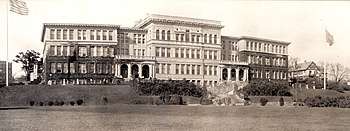
Rhode Island College was first established as the Rhode Island State Normal School by the Rhode Island General Assembly in 1854.[2] Its creation can be attributed to the labors of Henry Barnard, the first state agent for education in Rhode Island who had established the Rhode Island Teachers Institute at Smithville Seminary in 1845, and his successor, Elisha Potter. The Rhode Island State Normal School was one of the nation's first normal schools (teacher preparatory schools), which grew out of the humanitarian groundswell of the mid-19th century spurred by educational missionaries like Horace Mann. The school attracted hard working young people who came chiefly from ordinary backgrounds.
Not yet thoroughly convinced of the school's value, the General Assembly curtailed its financial support in 1857 and the school was moved to Bristol where it lingered until 1865 before closing. However, in 1869, the newly appointed state commissioner of education, Thomas W. Bicknell, began a vigorous personal campaign to revive the school.[3] His efforts were rewarded in 1871 when the General Assembly unanimously voted a $10,000 appropriation for the school's re-opening in Providence.
Renamed the Rhode Island Normal School, the institution settled into a period of steady growth punctuated by periodic moves to larger quarters.[4] The general favor won by the school, after its first difficult years had passed, was confirmed in 1898 when it moved into a large building specially constructed for it on Providence's Capitol Hill near the State House.
In 1920, the Rhode Island Normal School was renamed Rhode Island College of Education by order of the General Assembly. The college now offered a four-year program which upon a student's completion would grant a Bachelor of Education degree. At this time the observation school, which dated back to the 1890s, was renamed the Henry Barnard School. The college's graduate program also originated in the early 1920s and the first master's degrees were conferred in 1924.
For the next three decades the college remained a teachers' college with a student body of four to six hundred men and women. Early in the 1950s that calm was shattered by intense debate that arose over the college's role in the state system of higher education and for a time serious doubt was cast on its continued existence. There were plans to merge the institution with Rhode Island's other four-year college, the University of Rhode Island. After careful consideration, the Board of Trustees of State Colleges decided to keep the college independent and strengthen it overall.
In 1958, the college was moved to its current campus in the Mount Pleasant section of Providence. In 1959, the Rhode Island Commission to Study Higher Education recommended the development of the institution into a general college which was approved by the General Assembly. Reflecting the broadening of purpose, the institution's name was changed to its current name Rhode Island College in 1959.[2]
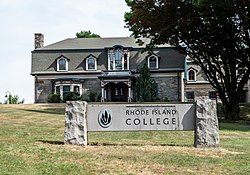
The East Campus includes the former grounds of the Rhode Island State Home and School for Dependent and Neglected Children, the first post-Civil War orphanage in the country. In recent years, many efforts have been undertaken by Rhode Island College and its benefactors to preserve the Yellow Cottage (or Cottage C), one of the original structures from the State Home.
Principals and presidents
Frank Sánchez is the tenth president, and 18th chief officer of Rhode Island College. The president is the chief executive officer; prior to 1920, the chief academic officer of the college was known as the principal.
| Principal | Years in Office |
|---|---|
| Dana P. Colburn | 1854–1859 |
| Joshua Kendall | 1860–1864 |
| James C. Greenough | 1871–1883 |
| Thomas J. Morgan | 1883–1888 |
| George A. Littlefield | 1889–1892 |
| William E. Wilson | 1892–1898 |
| Fred Gowing | 1898–1901 |
| Charles S. Chapin | 1901–1907 |
| John L. Alger | 1908–1920 |
| President | Years in Office |
|---|---|
| John L. Alger[5] | 1920–1938 |
| Lucius A. Whipple[6] | 1939–1950 |
| William C. Gaige | 1952–1966 |
| Joseph Kauffman | 1968–1973 |
| Charles B. Willard | 1973–1977 |
| David E. Sweet[7] | 1977–1984 |
| Carol J. Guardo[8] | 1986–1989 |
| John Nazarian[9] | 1990–2008 |
| Nancy Carriuolo | 2008–2016 |
| Frank Sánchez | 2016- |
Academics
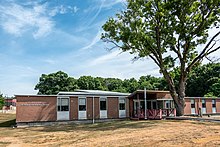
Academic programs at Rhode Island College are divided into five colleges: the Faculty of Arts and Sciences, the Feinstein School of Education and Human Development, the School of Management, the School of Nursing, and the School of Social Work. These schools offer more than 90 undergraduate and 30 graduate programs for students. Rhode Island College is accredited by the New England Association of Schools and Colleges. Among the five colleges, individual departments have received additional accreditation from the following associations: Council on Social Work Education, National Association of Schools of Art and Design, National Association of Schools of Music, National Association of State Directors of Teacher Education and Certification, National Council for Accreditation of Teacher Education, and the Commission on Collegiate Nursing Education. Forbes magazine ranked the college 618th.[10]
Student life

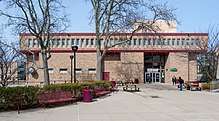
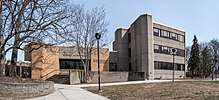
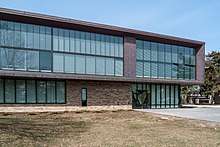
Enrollment is predominantly from Rhode Island, Massachusetts and Connecticut. 67% of students are female.
The school's newspaper is The Anchor, its radio station is 90.7 WXIN Rhode Island College Radio.
Active clubs on campus include Rhode Island College Programming, Future Elementary Education Teachers, Biology Club, Harambee, Debate Council, Henry Barnard School Mentors, L.I.F.E: Live, Inspire, Fight, Educate, Feminists United, Helping Others Promote Equality, Intervarsity Christian Fellowship, Latin American Student Organization, NSSLHA, Anchor TV, Rhode Island College Ballroom Dance Club, American Marketing Association chapter, the Ocean State Film Society, and the English Club. There are over 78 clubs on campus. The college's Music, Theatre and Dance department has a strong presence on campus.
Student activities and clubs on campus are governed and funded by Student Community Government, Inc., a semi-autonomous organization financed by the college's student activity fee, consisting of an executive board, parliament, and several committees. Student Parliament consists of 34 student positions and a number of by-lawed positions. Those positions include seats taken by administrators, faculty, staff and alumni. All student representatives of Student Parliament represent a constituency whose concerns they are supposed to represent throughout the academic year.
The James P. Adams Library is the main library. Students, faculty, staff, and the community have access to a wide variety of knowledge resources including electronic reference resources, e-books, databases, audiovisual materials, and special collections. The library is also the academic, social, and intellectual center of the campus, hosting a variety of lectures, exhibits and performances to the benefit of the campus community.
RIC has six residence halls which house 1,194 undergraduate students. Penfield Hall, a new $30 million, energy efficient, LEED-certified residence hall opened in 2007. The 125,000-square-foot (11,600 m2) building expanded the institution's existing housing capacity by 44%.[11]
The Interfaith Center is non-denominational with many religions, ethnic groups, and academic concentrations represented.
Greek life
Rhode Island College has recently seen an increase in Greek life on campus. The Greek Council consists of four fraternities and three sororities. Fraternities at Rhode Island College include Kappa Delta Phi, Iota Phi Theta, Phi Mu Delta and Kappa Sigma. Sororities at Rhode Island College are Theta Phi Alpha national sorority, Delta Phi Epsilon national sorority and Alpha Sigma Tau national sorority .[12]
Athletics
Rhode Island College teams participate as a member of the National Collegiate Athletic Association's Division III. The Anchormen are a member of the Little East Conference. Men's sports include baseball, basketball, cross country, golf, soccer, swimming & diving, tennis, track & field and wrestling; while women's sports include basketball, cross country, golf, gymnastics, lacrosse, soccer, softball, swimming & diving, tennis, track & field and volleyball. The Intercollegiate Athletic Arena, an 8,000 seat facility, is the home of the Rhode Island College Anchormen basketball teams.
Notable alumni
- David Bennett, Democratic member of the Rhode Island House of Representatives.
- Peter Boyer, Grammy Award nominated composer.
- Sharon Ellen Burtman, 1995 US Women's Chess Champion.
- Maria Cimini, former Democratic member of the Rhode Island House of Representatives.
- Viola Davis, Tony Award winning, Emmy Award winning, and Academy Award winning actress
- Allan Fung, an American politician and the first Asian-American mayor of Cranston, Rhode Island. Graduated in 1992.
- Ann Gale, American figurative painter.
- Raymond Gallison, former Democratic member of the Rhode Island House of Representatives.
- Al Gomes, Award-winning Music Producer and Songwriter.
- Maryellen Goodwin, Democratic member of the Rhode Island Senate.
- Robert J. Healey, attorney and politician, founder of Rhode Island's Cool Moose Party.
- Daniel Issa, Rhode Island State Senator.
- Nicholas Kettle, former Republican member of the Rhode Island Senate.
- James Langevin, 2nd District Congressman from Rhode Island.
- J. Michael Lenihan, former Democratic member of the Rhode Island State Senate.
- Steven Libman, nationally recognized performing arts leader known for producing dance, theatre, and multi-disciplinary performing arts series.
- John J. Lombardi, Democratic member of Providence City Council, and interim mayor following the conviction of Buddy Cianci
- Frank Lombardo, Democratic member of the Rhode Island Senate.
- Karen MacBeth, Republican member of the Rhode Island House of Representatives.
- Justine Mainville, keyboardist, drummer, singer for Math the Band.
- Ron McLarty, television actor and novelist. Graduated in 1969 and received an honorary doctorate in 2007.
- Mary Messier, Democratic member of the Rhode Island House of Representatives.
- Harold Metts, Democratic member of the Rhode Island Senate, former member of the Rhode Island House of Representatives.
- Patricia Morgan, Republican member of the Rhode Island House of Representatives.
- Jennifer Mudge, theatre and television actress.
- William O'Brien, Democratic member of the Rhode Island House of Representatives.
- Thomas Palangio, Democratic member of the Rhode Island House of Representatives.
- Annie Smith Peck, mountaineer, educator, and suffragist.
- Roger Picard, Democratic member of the Rhode Island Senate.
- Juan Pichardo, Democratic member of the Rhode Island Senate.
- Leonidas Raptakis, Democratic member of the Rhode Island Senate.
- Anaridis Rodriguez, journalist and news anchor for The Weather Channel.
- Jim Rose, sports anchor for WLS-TV in Chicago.
- Adam Satchell, Democratic member of the Rhode Island Senate.
- James Sheehan, Democratic member of the Rhode Island Senate.
- Danny Smith, Executive Producer, writer, and voice actor for television's Family Guy.
- Maureen Taylor, genealogist and author.
- Mary Tucker Thorp, educator and public speaker who graduated in 1929, while also teaching. The school's first residence hall is named in her honor.[13]
- Josephine Silone Yates, educator and chemist who was one of the first African-American women to hold a full professorship at a U.S. college or university.[14]
- Shunee Yee, corporate executive.
References
- As of June 30, 2009. "U.S. and Canadian Institutions Listed by Fiscal Year 2009 Endowment Market Value and Percentage Change in Endowment Market Value from FY 2008 to FY 2009" (PDF). 2009 NACUBO-Commonfund Study of Endowments. National Association of College and University Business Officers. Archived from the original (PDF) on December 14, 2017. Retrieved February 6, 2010.
- "About RIC - College History". www.ric.edu. Retrieved 20 May 2017.
- "NEA: Luminaries, NEA History, Leaders". Archived from the original on 6 July 2008. Retrieved 20 May 2017.
- "Rhode Island Colleges". Archived from the original on 25 January 2005. Retrieved 20 May 2017.
- "Rhode Island College Sesquicentennial". www.ric.edu. Retrieved 20 May 2017.
- "I25511: Alva Jerome Vincent (14 Jul 1868 - 9 Mar 1905)". Retrieved 20 May 2017.
- "Dr. David E. Sweet, 51, Dies; Head of Rhode Island College". The New York Times. September 18, 1984. Retrieved May 22, 2010.
- "College President Named". The New York Times. October 20, 1985. Retrieved May 22, 2010.
- https://www.forbes.com/colleges/rhode-island-college/
- "Archived copy". Archived from the original on 2009-09-17. Retrieved 2008-12-29.CS1 maint: archived copy as title (link)
- "Student Activities - Student Activities (SA) Greek Life". www.ric.edu. Retrieved 20 May 2017.
- Pezza, Kelly Sullivan (2015). Murder & Mayhem in Washington County, Rhode Island. Charleston, South Carolina: History Press. pp. 25–27. ISBN 978-1-62585-383-7.
- Kremer, Gary R.; Mackey, Cindy M. (1996). "'Yours for the Race': The Life and Work of Josephine Silone Yates". Missouri Historical Review. 90 (2): 199–215.